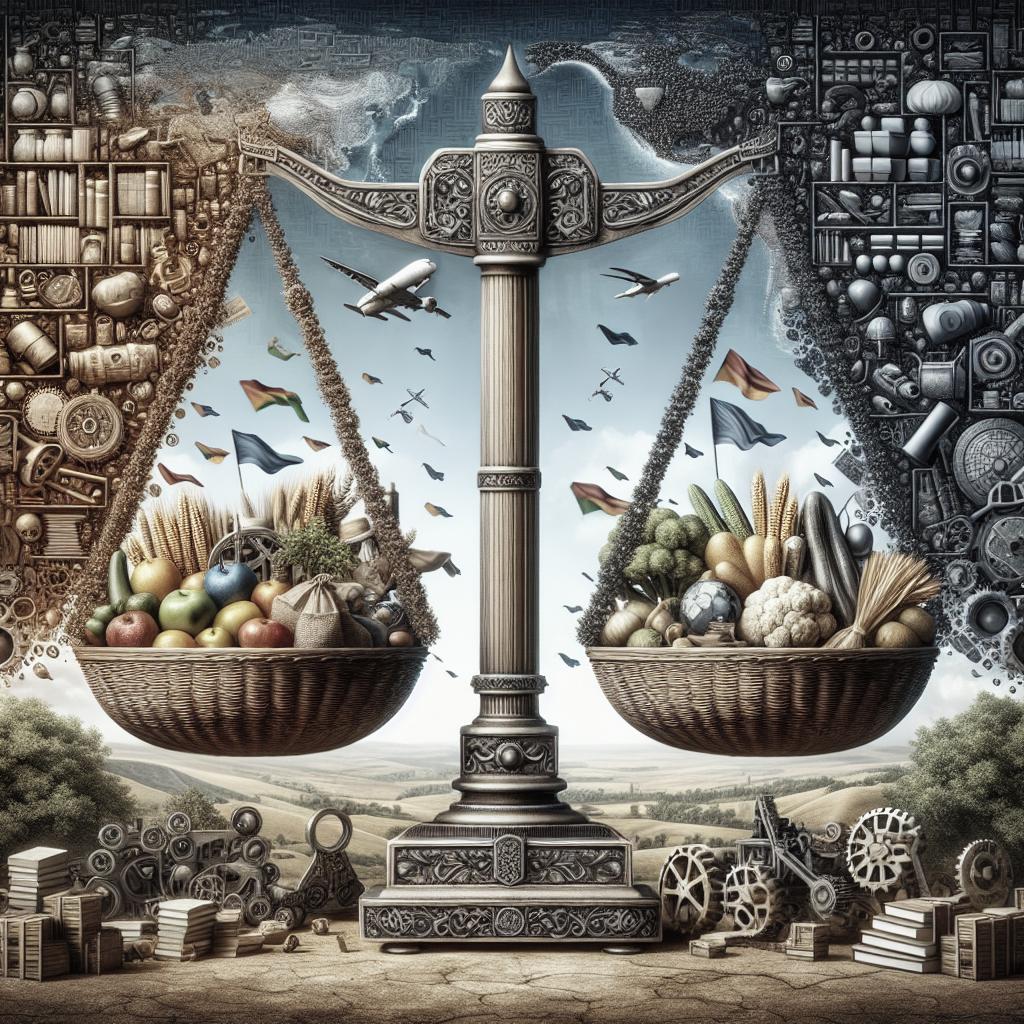Balancing Trade Between Nations
Trade between nations is a pivotal component of the global economy, influencing financial stability, economic growth, and international relations. A crucial aspect of international trade is the Balance of Trade (BOT), which measures the difference in value between a country’s imports and exports. Understanding the BOT is essential for policymakers, economists, and businesses alike as it impacts currency value, economic strategies, and bilateral ties. This blog post will delve into the intricacies of the Balance of Trade, from definitions to calculations and examples, touching upon related concepts such as trade surplus, trade deficits, and exchange rate effects. Future prospects in trade balance analysis and how it shapes global economic policy are also discussed. Join us in exploring how nations strive to balance trade, foster economic health, and enhance global cooperation.
What Is the Balance of Trade (BOT)?
The Balance of Trade (BOT) is a vital economic indicator that quantifies the difference in value between a country’s imports and exports over a specific period. It serves as a crucial component of a nation’s balance of payments and reflects its international economic engagements. A positive BOT, or a trade surplus, occurs when exports exceed imports, indicating a net inflow of foreign currency. Conversely, a negative BOT, or a trade deficit, implies that a country imports more than it exports, leading to a net outflow of domestic currency.
The BOT plays a significant role in shaping a nation’s economic policy, impacting currency value, investment inflow, and trade relations. It can also influence economic growth, as a trade surplus can indicate a competitive industrial sector, while a trade deficit might suggest reliance on foreign goods or resources. Understanding the nuances of BOT enables economists and policymakers to make informed decisions about tariffs, trade agreements, and other economic strategies that shape a nation’s global economic standing.
Understanding the Balance of Trade (BOT)
To comprehend the Balance of Trade, it is crucial to understand the underlying elements that affect it, including market demand, production capacity, and international competitiveness. Facets such as domestic economic policies, consumer preferences, and global trade dynamics all impact the BOT. Analyzing these elements helps identify trends, challenges, and opportunities in international trade.
Understanding BOT also involves considering external factors like geopolitical events and global economic fluctuations. Such forces can unexpectedly alter the balance, necessitating adaptive strategies to maintain economic stability. A thorough analysis includes evaluating how trade policies, such as tariffs or trade agreements, influence the flow of goods and services across borders, further impacting the BOT.
Calculating the Balance of Trade
Calculating the Balance of Trade involves subtracting the value of a country’s imports from the value of its exports over a given time frame. A simplified formula to calculate the BOT is: BOT = Exports – Imports. A positive result indicates a trade surplus, while a negative result suggests a trade deficit.
Economists and analysts gather data from trade reports, customs documents, and economic databases to compute this metric accurately. The complexity arises when considering factors like trade in services, which must also be included alongside tangible goods to depict a comprehensive BOT. This calculation provides insights into a nation’s economic health and informs decisions on fiscal policy and international agreements.
Examples of Balance of Trade
Historically, countries like China and Germany have experienced sustained trade surpluses due to their robust manufacturing sectors and competitive exports. These nations exemplify how a positive BOT can enhance economic prosperity and strengthen global influence.
On the other hand, countries like the United States frequently run trade deficits, importing vast quantities of goods, such as electronics and automobiles. This scenario reflects high domestic consumption compared to production, leading to a complex economic landscape where BOT considerations are integral to formulating trade and industrial policies.
Balance of Trade: Surplus vs. Deficit
A trade surplus indicates an economy that effectively produces goods and services desired internationally, leading to a favorable exchange of capital. This can bolster national savings, enhance currency strength, and support economic growth. However, excessive reliance on exports can expose an economy to external demand fluctuations.
Conversely, a trade deficit suggests an economy that spends more on foreign goods than it earns from exports. While often perceived negatively, trade deficits can signal strong consumer demand or investment-driven growth. Nonetheless, persistent deficits may trigger debt accumulation or currency depreciation, necessitating strategic measures to address economic imbalances.
Special Considerations
When assessing BOT, it is vital to consider the nature of traded goods and services, as high-value industries like technology or luxury goods can skew trade figures. Additionally, global supply chain disruptions or protectionist policies, such as tariffs and quotas, may impact BOT calculations by altering trade dynamics.
Environmental and ethical considerations also play a role, as certain trade practices, such as outsourcing or resource extraction, carry implications beyond immediate economic metrics. These factors require balanced approaches that address both economic and sustainable development objectives in international trade discussions.
Balance of Trade vs. Balance of Payments
While the Balance of Trade focuses specifically on the exchange of goods and services, the Balance of Payments (BOP) provides a broader picture of all economic transactions between a nation and the rest of the world, including financial capital and transfer payments. The BOP encompasses the current account, capital account, and financial account.
Understanding the relationship between BOT and BOP is essential, as trade surpluses or deficits directly influence the current account, which forms part of the BOP. Therefore, policymakers must consider both metrics when formulating economic strategies to ensure sustainable and balanced international economic relations.
How Do Changes in a Country’s Exchange Rate Affect the Balance of Trade?
Exchange rate fluctuations significantly impact the Balance of Trade by altering the relative prices of exports and imports. A depreciation in currency value makes exports cheaper and imports more expensive, potentially improving BOT by boosting export volumes and reducing import demand.
Conversely, currency appreciation can harm BOT by making exports costlier and imports cheaper, potentially increasing the trade deficit. These dynamics require careful management of monetary and fiscal policies to stabilize currency values and maintain competitive trade positions globally.
What Is a Trade Surplus?
A trade surplus occurs when a country’s export value surpasses its import value. It reflects economic efficiency, as the nation effectively competes in international markets by producing goods and services that meet global demand. Trade surpluses often result from a competitive manufacturing sector or strategic export support policies.
Countries with consistent trade surpluses typically enjoy stronger currencies, increased national savings, and favorable investment conditions. However, focusing excessively on exports might limit domestic consumption, necessitating balanced economic approaches to sustain long-term growth and stability.
How Can a Country Gain a Trade Surplus?
To achieve a trade surplus, countries can enhance their export competitiveness through innovation, quality enhancement, and cost-effectiveness. Government support in the form of trade agreements and subsidies can further facilitate increased export activity, positioning domestic industries favorably in global markets.
Additionally, diversifying export products and markets reduces reliance on singular sectors or trading partners, cushioning economies against external shocks. Investing in technology and human capital also strengthens a country’s ability to compete internationally, contributing to sustained trade surpluses over time.
How Do We Measure Balance of Trade?
The Balance of Trade is measured using international trade data compiled through customs records, trade reports, and economic statistics. Accurate measurement involves considering both tangible goods and intangible services to reflect the complete economic interactions between a nation and the world.
This measurement process enhances transparency and allows for informed assessments of a country’s economic position, aiding policymakers and analysts in crafting strategies that respond effectively to global trade trends and challenges.
The Bottom Line
Key Takeaways
Understanding the Balance of Trade is crucial for grasping a nation’s economic health and international trade dynamics. Through careful calculation and analysis of BOT figures, policymakers and economists can devise strategies that promote sustainable growth, economic stability, and beneficial international relations.
Example of How to Calculate the BOT
Consider a hypothetical country with exports amounting to $200 billion and imports totaling $180 billion over a year. By applying the formula BOT = Exports – Imports, the BOT calculation yields a positive $20 billion, indicating a trade surplus.
| Concept | Description |
|---|---|
| Balance of Trade (BOT) | Measures the difference in value between imports and exports. |
| Trade Surplus | Occurs when exports exceed imports, reflecting positive BOT. |
| Trade Deficit | Occurs when imports exceed exports, indicating negative BOT. |
| Exchange Rate Impact | Currency value changes can affect relative export and import prices. |
| Balance of Payments | Includes BOT as part of current account, alongside financial flows. |


